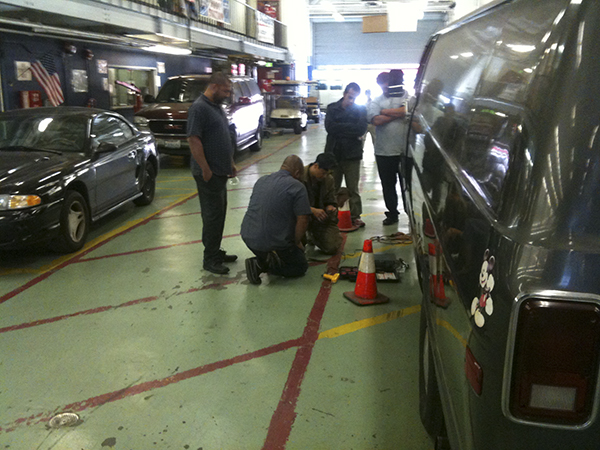California-Diesel-Regulations
California-Diesel-Regulations: Smoke Test
Step 1 - Vehicle Preparation
• Check that there are no obvious safety hazards (abnormal engine noise, overheating, leaking fluids, etc.). Inspectors may reject a vehicle that is unsafe to test.
• Place the transmission in “Neutral” or “Park,” with the parking brake on and/or wheel chocks in place.
• Turn off all accessories (including air conditioning).
• Ensure the vehicle is at normal operating temperature.
• Position the vehicle to ensure there are no drafts that can disturb the exhaust plume.
• Ensure there is nothing in the shop environment, such as equipment or tool boxes, which
prevents the inspector from clearly observing the exhaust plume. In general, this will require
clearing the line-of-sight as much as 15 feet from the tailpipe(s).

Step 2 - Test Preparation and Vehicle Familiarization
• Use any means necessary to enable observation of the vehicle’s exhaust plume, including but not limited to, adjusting the seat and mirror positions.
• Do not check for smoke during the first BAR Snap Test. Any visible smoke observed during the first BAR Snap Test shall not result in a failure.
Step 3 - Perform the Idle Test
• Have the engine running at idle and go to the vehicle’s tailpipe.
• Perform the Idle Test: - Diesel the idle test shall be performed at the appropriate OIS prompt.
• Observe the tailpipe(s) exhaust plume of the vehicle for 10 seconds.
California-Diesel-Regulations
California-Diesel-Regulations: Smoke Test
Step 4 - Perform the Crankcase (PCV) Test
• After performing the Idle Test (Step 3), continue to leave the vehicle’s engine running at idle and go to the vehicle engine compartment. Open the hood to the engine compartment and determine whether any smoke is coming from the crankcase (PCV) system.
• Observe the vehicle’s crankcase system for 10 seconds. Note: do not perform this test on vehicles originally equipped with an open crankcase.
Step 5 - Complete the BAR Snap Test
• Perform the first of three BAR Snap Tests:
• Ensure the vehicle’s engine RPM falls between 2,000 and 3,000 while performing the first BAR Snap Test. If it does not, you can do one of the following: - Press-and-release the accelerator pedal more quickly or more slowly as needed to stay within the designated RPM range; or - Quickly press the pedal only part way to the floor before releasing it.
• Continue to leave the vehicle’s engine running at idle.
• Perform the final two BAR Snap Tests.
• Perform the second BAR Snap Test while watching for visible smoke.
• Return the engine to idle, and wait for at least 3 seconds to allow the engine to stabilize.
• Perform the third (and final) BAR Snap Test while watching for visible smoke.
California-Diesel-Regulations
California-Diesel-Regulations: Smoke Test
Step 6 - PASS/FAIL Determination
• PASS the vehicle for the Visible Smoke Test portion of the Smog Check inspection if the vehicle does not emit smoke during the Idle Test, Crankcase Test, and both of the final two BAR Snap Tests.
• FAIL the vehicle if: - There is any visible smoke observed during the Idle Test; - OR there is any visible smoke coming from the crankcase (PCV) system; - OR there is:
• Diesel - a visible smoke plume observed 5 to 15 feet from the tailpipe(s) that lingers for more than 3 seconds on either of the final two BAR Snap Tests.
• Smoke from any area other than the vehicle’s tailpipe(s) or crankcase (PCV) system, regardless of the cause, does not constitute a failure of the Visible Smoke Test.
Foe an example if there is smoke coming from any other area like the side draft tube but the tailpipe and PCV system passes. The vehicle will pass for the visible smoke test.
• No vehicle shall be failed for condensation or steam.
Step 7 – Enter the Test Results into the OIS
• Results must be entered at the “Enter Result of the Exhaust System Smoke Check” and “Enter Result of the Crankcase System Smoke Check” OIS prompts.
• For vehicles that pass a portion of the Visible Smoke Test, enter “P” (Pass) at the appropriate prompt.
• For vehicles that fail a portion of the Visible Smoke Test, enter “F” (Defective) at the appropriate prompt.
Step 8 - Documentation Provided to the Customer
If the vehicle fails the Visible Smoke Test, the inspector shall:
• Document the failure on both the customer’s and station’s copy of the Vehicle Inspection Report (VIR) in the “Other Emission Related Components” section. Make a clear notation on the VIR, such as “Failed Visible Smoke Test”. Document what portion of the Visible Smoke Test the vehicle failed, such as “Crankcase Smoke,” “Idle Smoke,” and/or “BAR Snap Smoke.”
• Document the failure on the customer’s invoice with “Failed Visible Smoke Test”. Document what portion of the Visible Smoke Test the vehicle failed, such as “Crankcase Smoke,” “Idle Smoke,” or “BAR Snap Smoke.”
B.A.R WEBSITE: Click Here
Return to Smog Inspector Home Page
AFOC: SMOG CLASS PRACTICE EXAM - Diesel Regulations
Click Link Below For Next Smog Inspector Practice Test
Smog Tech Pre Exam: Aftermarket Parts Regulations
CLASS SCHEDULES
Emission Control 1:
B.A.R. Smog Check
Inspector Level 1
(Inspector "Smog" License):
Engine Fundamentals
8am - 12:15 pm
Summer Class
7/5/2022 -8/5/2022
Class # 799065
Emission Control 2:
B.A.R. Smog Check
Inspector Level 2
(Inspector "Smog" License):
Rules and Regulations
8am - 12:15 pm
Summer Classes
7/5/2022 - 8/5/2022
Class # 799067
Engine Performance 1:
8am - 12: 15 pm
Date: TBD
Class # 799069
Engine Performance 2:
B.A.R. Specified Diagnostic
and Repair Training
(Repair "Smog" License)
Time: TBD
Date: TBD
Class # 799071
Emission Control 1
(Inspector "Smog" License):
5:00pm - 8:45 pm
Date: TBD
Class # 799065
Emission Control 2:
(Inspector "Smog" License):
5:00pm - 8:45 pm
Date: TBD
Class # 799065
Exhaust Emissions (Update Class):
5:30 pm - 8:45 pm
Tuesday nights:
Dates: coming soon
Class # 796070